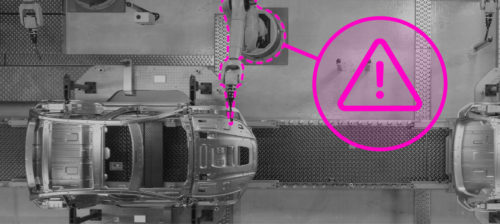Value of change in maintenance: Altering routines is a worthwhile investment
It was late Wednesday night. The hot midday sun was just a memory for the two men as they waited to hear something, anything, from their companion. The air around them was heavy with anticipation as they looked over their shoulders, across the vast expanse, back toward the shack. Then, in unison, their gaze shifted down to peer at the ugly sight just inches from their feet.
It was late Wednesday night. The hot midday sun was just a memory for the two men as they waited to hear something, anything, from their companion. The air around them was heavy with anticipation as they looked over their shoulders, across the vast expanse, back toward the shack. Then, in unison, their gaze shifted down to peer at the ugly sight just inches from their feet.
It wasn’t pleasant to look at; the guard had been ripped apart by flying metal debris. The cover and grid lie on the ground in a grotesque, distorted pose, clear evidence that someone had not performed his assignment that week. Silently they swore to themselves as the third member of their group came running down the walkway over the kiln, screeching to a halt before them.
“Guys, I hate to tell you but they don’t have one up there!” he panted.
They both looked at him in disbelief and shouted, “What do you mean they don’t have one!?”
“Well, do you guys remember last month when we used one over on the cooler? According to the warehouse guy, nobody told him that we took it, so he says he didn’t know he needed to buy another one! I guess we can’t blame him, since it’s our own fault for not reporting we took the other one.”
Later, a sound echoing off the giant metal structures, the roar of the Night Production Supervisor, was heard throughout the entire plant compound. “I’m going to be down for HOW LONG?!
Sound familiar? All too often, this scenario plays out in a surprisingly large number of plants and critical production operations. With individual plant production hourly downtime equating to thousands, or even tens of thousands of dollars, the impact of not having a vital part when it is needed is significant. This kind of situation can be avoided if just two simple, yet critical, maintenance performance practices are consistently performed.
Planned Maintenance action
First, someone neglected to perform a scheduled Planned Maintenance (PM) action on the coupling that would have identified the potential for failure and would have allowed sufficient time to correct the problem before failure and the resulting down time occurred. Failure to perform a scheduled PM, in itself, is a poor maintenance practice and, as shown in this ‘mini-dramatization,’ can cause real problems for production. More far-reaching are the snowballing effects of lost sales, missed deliveries, dissatisfied and potentially lost customers, and increased cost per item produced, meaning either lost profit or reduced competitiveness.
CMMS implementation
Second, and an even worse example of poor maintenance practices, is the fact that the needed part would have been immediately available and on the shelf if a maintenance person had just reported the use of an item on a previous job. Installing and implementing a Computerized Maintenance Management System (CMMS) can be the solution for this and a multitude of other problems that result in reduced reliability and loss of production capacity. Simply performing and closing a planned maintenance action would have triggered the CMMS to initiate a purchase requisition to replenish supply.
Maintenance personnel are universally concerned about and zealous in keeping their assigned equipment operating. They will usually do whatever is required to keep the facility operating by responding quickly to breakdowns and failure reports under nearly all circumstances. Unfortunately, that “response-to-failure” style is not their primary responsibility. The maintenance function is to maintain — that means to preserve good equipment operating condition and protect against failures. The maintenance staff should predominantly be involved with maintaining, not repairing.
Flavor of the month
Like all other human beings, maintenance personnel do not like changes in their customary and normal routines, and they do not take well to management adopting new programs that will significantly alter their culture — the methods and processes they have learned through constant practice. Nearly always, they view new initiatives as a “flavor of the month” project dreamed up by some manager and, through experience, they have learned that after everybody gets tired of this one, it will be abandoned, and another one will soon follow.
On the other side of the coin, most managers view the maintenance person as stubborn and hard-headed, bucking every attempt to improve reliability through a change of normal work processes. As a practitioner, the maintenance person is expected to follow the new process, but not to have any involvement in choosing and implementing the process changes. In practice, their involvement with, and education in, the “why’s, wherefore’s and how’s” is crucial to a new project’s success.
Management training
When implementing a CMMS or other initiative in a manufacturing environment, significant attention should be given to ensuring that every manager and supervisor associated with the implementation is well trained and coached in the how’s and why’s of the project, including the benefits to be realized from the effort.
In turn, they should be expected to educate and involve all of their staff personnel. Quite often these critical players, the ones who can make or break the project, are completely, or at least partially, left out of the picture.
During a recent storeroom reorganization project for a multisite raw materials producer, meetings were conducted with maintenance personnel at each site to discuss the project. Additionally, these discussions addressed the concerns and functions of other plant personnel to provide the maintenance staff with different perspectives of various maintenance support functions.
Even obvious facts, like the Storeroom Supervisor can’t be expected to conduct a physical count of the entire storeroom every morning to see what’s been removed from the shelves overnight, gave them cause to stop and think of all the ramifications of their actions.
The importance of the implementation project, both at their level and the corporate level, was discussed, particularly to make sure that they understood the benefit of coming aboard and supporting the effort which would make them more efficient in their daily maintenance activities.
Limited access
One of the most difficult changes for these maintenance personnel to accept was the logic in locking the storeroom and limiting access after normal working hours. Completely open storerooms were so prevalent that most maintenance personnel felt they wouldn’t be able to accomplish their job without unfettered access. Once they understood the logic in protecting all of these parts so critical to their operation, there was little opposition to transitioning from an open storeroom to a locked storeroom.
The results of the extra effort to involve the maintenance personnel in the project are impressive. Where previously very few parts taken from the storeroom were logged after normal hours, now the Parts Log was full every morning.
Instead of walking into the storeroom and shopping for parts, the maintenance personnel came to the Storeroom Supervisor for assistance in finding parts, making sure that the parts were issued to Work Orders or Equipment. Maintenance personnel visiting the storeroom near the completion of the implementation project at each site universally commented on the improved storage scheme and cleanliness of the storeroom, noting how easy it would be in the future to locate parts.
Conclusion
The benefits of taking just a little extra time to explain new projects and obtain working-level input regarding work process changes far outweighs the cost of that effort.
It is just human nature to resist change. People will fight for every inch if they don’t understand the reasons behind the change. However, they will be at the front of the line, taking on a supporting role once they understand the logic and value of the change.
Author Information
Bob Call is a Maintenance Engineering Implementation Specialist with Life Cycle Engineering, Inc. Mr. Call has more than 25 years experience in maintenance management, maintenance development, Computerized Maintenance Management System (CMMS) implementation projects and maintenance training. He specializes in CMMS selection and implementations, and Spare Parts Storeroom reorganization. He can be contacted at Robert.W.Call@LCE.com .
Do you have experience and expertise with the topics mentioned in this content? You should consider contributing to our CFE Media editorial team and getting the recognition you and your company deserve. Click here to start this process.





